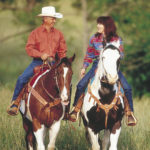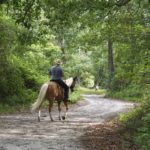First Steps

If you’re thinking about moving into the reining arena, here are a few must-do steps for a strong start:
1.Work with a trainer?at least in the beginning. Reining is a highly skilled riding discipline. It’s very difficult to train yourself?and be successful?without a pro?s help.With guidance from a competent trainer, you’ll learn and finesse basic reining skills, and then be on your way to competing.
2. Look for a reining affiliate in your area. Go to the National Reining Horse Association?s Web site(nrha.com). There, you can find NRHA affiliates in or around your area. The NRHA established their affiliate championship program to develop reining clubs at the grassroots level, which is a great way to get riders, such as yourself, involved in the sport.
3.Watch some reining classes. (Check nrha.com for a list of events in your area.) There are varying skill levels in reining, just as there are in other riding competitions.
While it can be inspiring and educational to watch more advanced reiners, I suggest you observe the lower-end classes first. These are called ?green reining? classes (and by ?green? I’m referring to the rider, not the horse); rookie classes are the next step up. By observing the green classes you’ll get an idea of what you’ll be doing when you start showing.
If you first (or only) watch the high-level classes, you’ll likely be overwhelmed by those riders? levels of expertise. It?d be like wanting to take up running, and starting training by watching an Olympic race.
4. Be prepared to start at the bottom, and work your way up. The green-class patterns are often modified, compared to those of the high-level reiners.
For example, in some associations, instead of having to do four spins, the green patterns call for two spins; riders can execute simple lead changes on circles instead of flying changes; instead of a sliding stop, riders can halt on rundowns. This helps newbie reiners progress gradually, solidifying their skills and building their confidence. Always check your local club?s or association?s rules.
Find the Best Trainer?For You
Finding a trainer who fits with your philosophies, interests, and goals can get you off to the right start.
Do your homework, and use some of the following tips for selecting a reining trainer.Make a list of possible trainers using some of these strategies:
– Ask other trainers you know for recommendations. Find a trainer who works well with your training level and philosophies.
Getting Started in Reining
– Ask around at your feed or local tack stores.
– Wander around the stall/warm-up areas at a green show, and watch riders warming up with their trainers. Listen carefully. Observe each trainer?s teaching style and level of expertise. If you find one you think would suit you, be outgoing and ask about his/her training program. (If the trainer appears preoccupied with show duties, ask for a business card.)
– Talk to competitors. They?re always good sources, because they likely know multiple trainers.
– Go to NRHA?s Web site and scan their list of NRHA Professional trainers in your area.
Once you?ve identified potential trainers, consider:
– The trainer?s teaching style.
– How knowledgeable he or she is about reining.
– The trainer?s attitude and general philosophy on training/showing.
– Whether he/she does private or group lessons(or both).
Know what fits your learning style. Many assume private lessons are always better than group lessons because of the highly concentrated attention from the trainer. It’s been my experience that group lessons can be more beneficial. You can always learn from others? mistakes, as well as their successes?and you often find that students in group lessons are more able to relax and enjoy what they?re doing. Plus, when you see others making the same mistakes you are, it’ll build your confidence,as you won?t feel as embarrassed over your mistakes.
– The trainer?s specialty. Some NRHA professionals specialize in aged events and very rarely tutor beginning reiners.Their barns are full of futurity and derby horses, and the only non pros they mentor are those involved in aged events, which, of course, isn?t where you’re at right now. Don?t be afraid to ask that question. He or she might suggest other competent local trainers to help you get started.
– How much he/she charges for lessons and other training.
The ABC?s of Getting Started
Your trainer should walk you through the basics of reining prep, but when you’re practicing on your own, here are a few exercises to help you improve your reining skills.
– Practice making perfectly round circles by setting up a cone at the center point. Eyeball a specific distance to the center and make sure you stay there as you circle around the cone. If you have trouble maintaining an even distance, keep practicing?no egg-shaped circles!
– Drill simple steering exercises (circles, half circles, turns throughout the arena). Good steering skills are imperative to good reining skills.
– Practice stopping your horse with a verbal cue: We train a verbal cue (?whoa?) and a leg cue, and don’t forget to refine and use your rein cue.
– Do upward and downward transitions. Just because reiners slide to a stop in the ring every time, that doesn’t remove the need to do transitions from lope to trot, trot to walk, etc. Resistance you find here will likely appear in your slides.
Repeat in both directions on a straight line, and on circles.
– Use ?fencing.? This is done when you practice ?pseudo? sliding-stop rundowns by traveling on a straight line down the center of the arena (at a walk, trot, and lope) and stop near the end of the arena. To get a sense of how fencing works, watch pros doing it at a show.
– Practice envisioning a smooth, flowing ride with you and your horse moving as one. Remember that, according to the NRHA handbook, the goal of reining is to have a horse that is ??willingly guided or controlled with little or now apparent resistance.?
Excerpted from Team Horse & Rider, ?Reining 101,? Horse & Rider.





